Insights from the United Kingdom’s People with Significant Control register
4. Results
4.1 Overview of the UK PSC register
The UK PSC register includes records on approximately 5.2 million individual beneficial owners and 6.1 million entities, suggesting an average ratio of one natural person per entity. It also contains 6.5 million recorded relationships between owners and entities, of which 96% are linked to individual beneficial owners and 4% to intermediary entities.
These relationships account for 14.2 million declared interests, indicating that each relationship typically involves two to three types of ownership or control. Among these, shareholding is the most commonly reported interest (41%), followed by voting rights (31.9%) and board appointment rights (22.6%). Less frequently reported are other forms of influence or control (4.2%) and rights to surplus assets on dissolution (0.3%). For both shareholding and voting rights, the most frequent reported threshold range is 75–100%, comprising 56% of all such interests. This suggested that many entities are fully owned and controlled by a single beneficial owner, reflecting a pattern of concentrated ownership and decision-making power.
The expected pattern of two to three interests per relationship is confirmed when analysing the combination of interests held by beneficial owners across all 6.1 entities (outlined in Figure 3). The most frequent scenario involves a single beneficial owner holding shares, voting rights, and board-appointment rights simultaneously. This is followed by two categories with nearly equal prevalence: shareholding alone; and a combination of shareholding and voting rights. A significant number of interests fall under the category of “other influence or control,” warranting further investigation to better define and interpret the nature of these relationships.
Figure 3. Top ten most common interest types and combinations
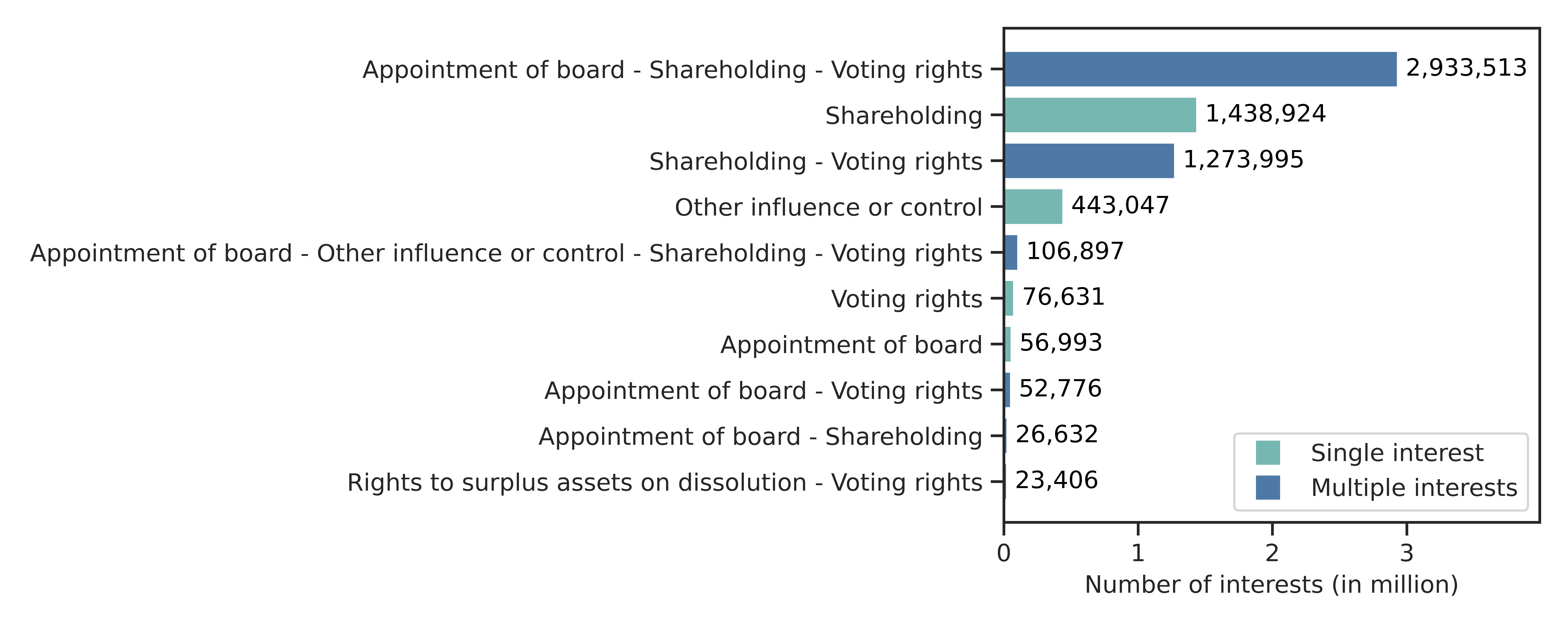
4.2 Entities with no individual beneficial owners
Some entities do not list any individual beneficial owners. Out of the 6.1 million entities in the dataset, 1,201,176 (20%) do not have a registered individual beneficial owner. Among these, 1,114,708 entities (93%) lack any BO record at all. This may reflect instances of noncompliance, data entry errors, or the use of legal provisions in the UK that exempt entities from registering a beneficial owner when no individual meets the disclosure threshold (e.g. when no individual holds more than 25% of shares or voting rights, or exercises control through other means). Unlike many jurisdictions, the UK does not require a senior manager to be listed in such cases.
The remaining 86,468 entities (7%) report at least one intermediary entity as a corporate beneficial owner. Notably, 64% of these are linked to only a single intermediary entity (Figure 4). However, there are notable outliers: in some cases, entities have listed up to 18 intermediary entities, suggesting a high level of structural complexity that may warrant further scrutiny.
Figure 4. Distribution of the number of intermediary entities (as corporate beneficial owners) per entity
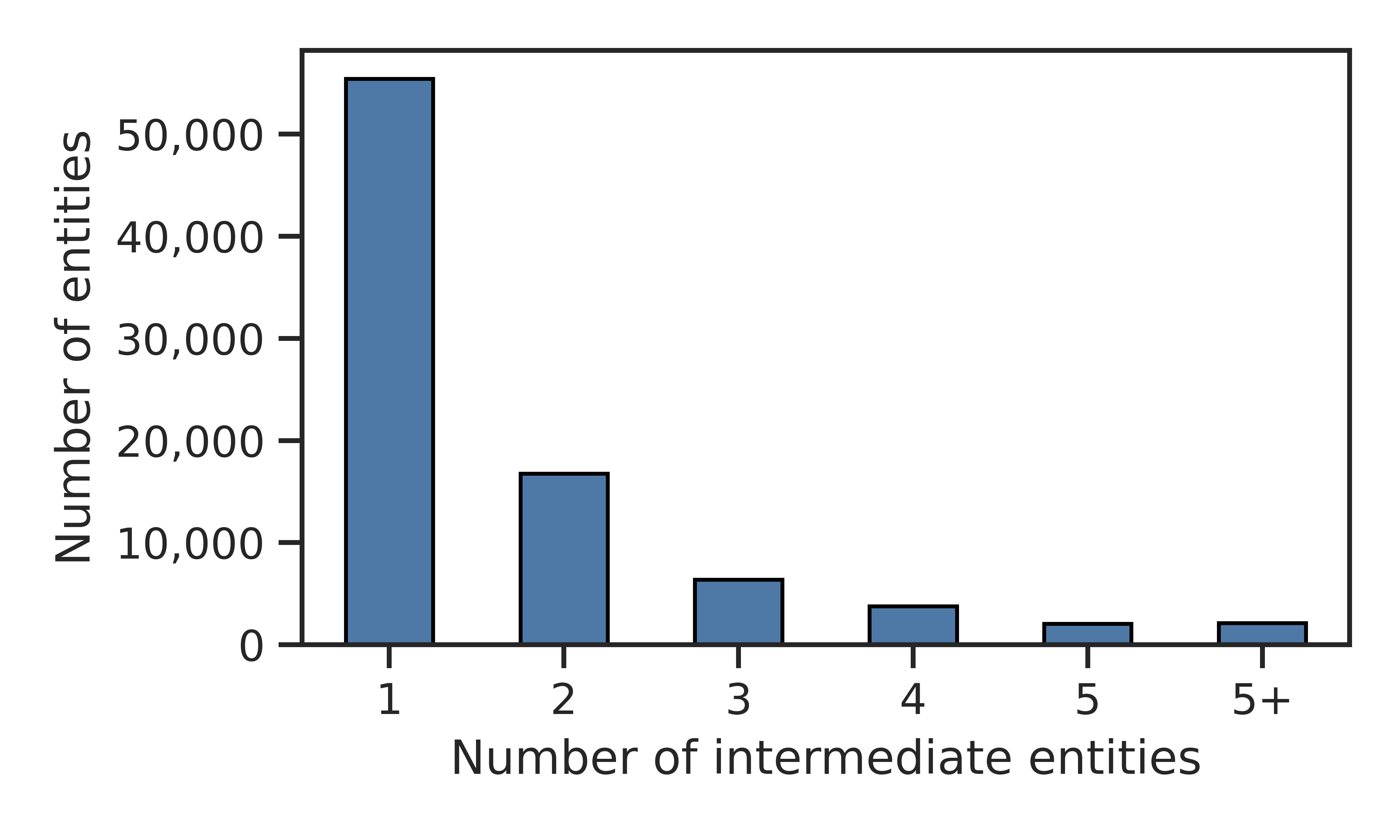
4.3 Individual beneficial owners with multiple entity connections
The dataset reveals that 644,405 individual beneficial owners – around 12% of the 5.2 million total – are linked to more than one entity. While the majority are connected to just two entities, some individuals exhibit significantly higher levels of ownership concentration (Figure 5).
Figure 5. Distribution of entities linked to individual beneficial owners with multiple entity connections
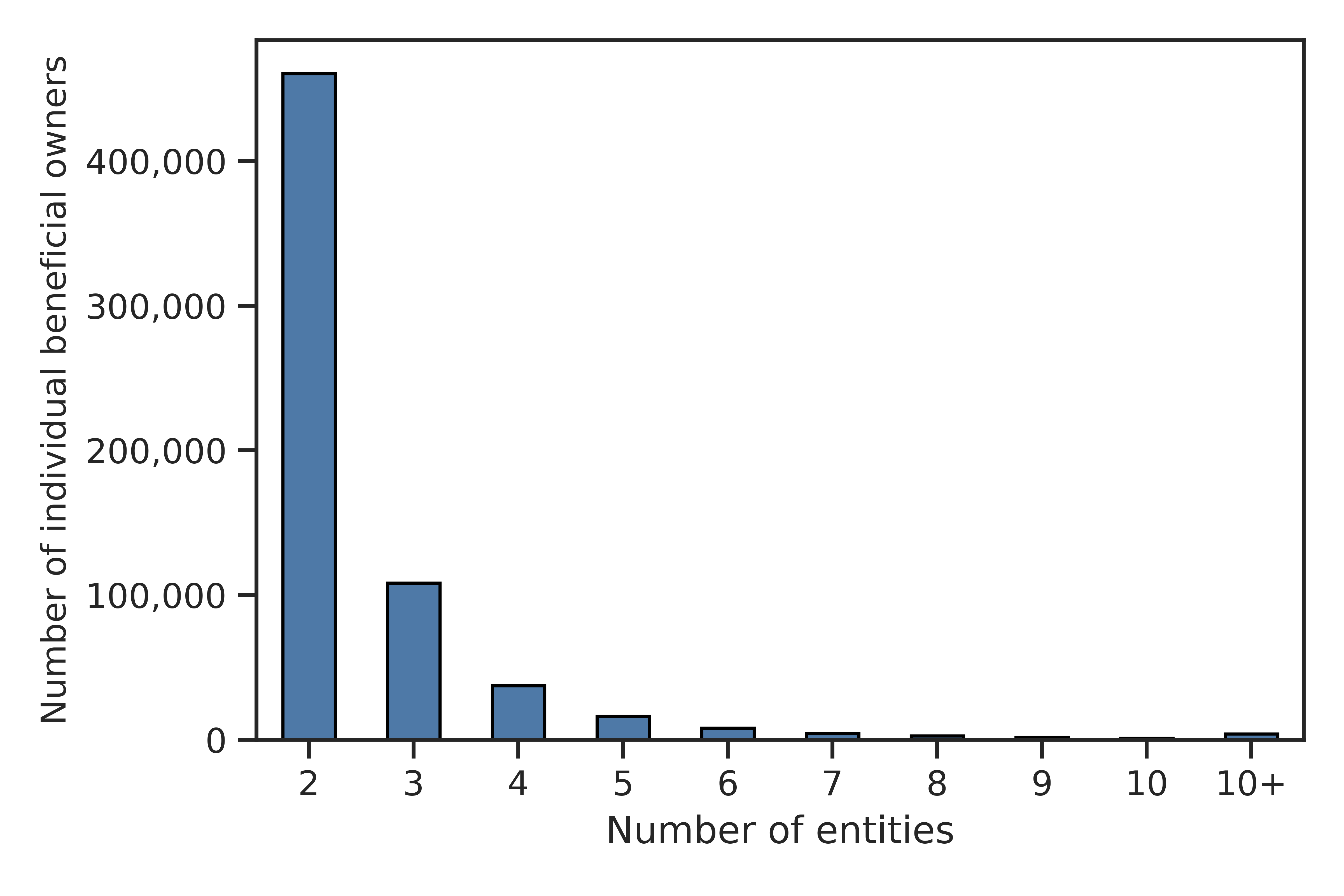
Although acting as a nominee is not illegal in many jurisdictions, and the use of nominee shareholders does not inherently signal wrongdoing, such arrangements can obscure the identity of the true beneficial owners. This opacity may be exploited for illicit purposes, warranting further scrutiny. Authorities should verify that nominees are not being recorded in place of actual beneficial owners and assess whether these structures are being used to evade transparency.
The most extreme case observed in our analysis involves an individual who appears in the UK PSC register as the beneficial owner of 1,296 entities. According to prior investigations by civil society organisations, the same individual is linked to a UK company-formation agent known for supplying so-called “shelf companies” – dormant, pre-registered companies kept for resale to clients who prefer buying an existing entity instead of setting up a new one. [26]
The remaining individuals in the top five beneficial owners with the most links to entities are closely behind, with 1,064, 810, 665, and 654 connections, respectively. All five also appear in external investigative resources, such as the latest Aleph dataset by the Organized Crime and Corruption Reporting Project (OCCRP). [27]
Although no wrongdoing is suggested solely by the registered data, instances where individuals are linked to an exceptionally large number of entities may signal potential risks or irregularities. Individuals associated with more than 20, or even 100, entities are likely to be either senior managers or nominees acting on behalf of others – patterns which warrant closer investigation.
4.4 Individual beneficial owners with single entity connections
Out of the 5.2 million individual beneficial owners in the UK PSC register, 4.5 million (88%) are linked to just one entity. Within this group, approximately 1.4 million (31%) hold a single type of interest, while the remaining 3.1 million (69%) declare multiple types of interests in the same entity.
Individual beneficial owners with a single interest in a single entity
Among the 1.4 million individual beneficial owners who hold a single type of interest in a single entity, shareholding is the most common type (74%), followed by other forms of influence or control (20%) (Figure 6). These patterns reveal notable connections:
- Around 1 million individual beneficial owners hold shares but lack voting rights. Of these, 55% fall within the 75–100% shareholding range, suggesting sole ownership by a single person.
- Approximately 280,000 individuals report other influence or control without shareholdings or voting rights. These cases may involve senior managers who are not necessarily required to register in the UK.
- Nearly 45,000 individuals report voting rights without shareholdings. Among them, almost 79% fall within the 25–50% threshold, indicating entities with two to four beneficial owners sharing voting control.
Figure 6. Distribution of interest types for individual beneficial owners with a single interest in a single entity
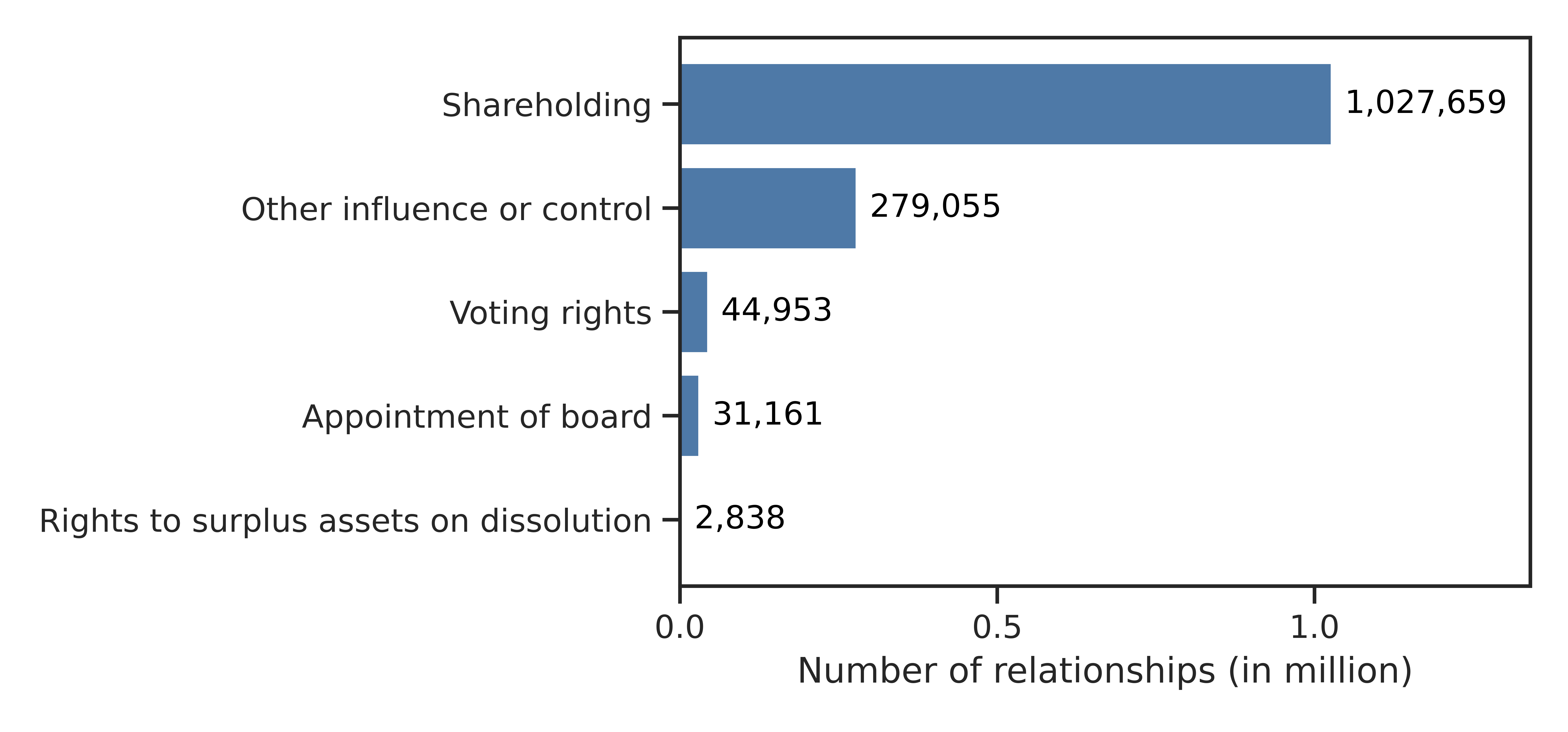
Individual beneficial owners with multiple interests in a single entity
Among the 3.1 million individual beneficial owners who hold multiple types of interests in a single entity, the most common combination – accounting for 66% (2.1 million) – includes shareholding, voting rights, and board-appointment rights. The second most frequent combination involves shareholding and voting rights, representing 28% of cases (Figure 7).
Figure 7. Top ten interest combinations for beneficial owners with multiple interests in a single entity
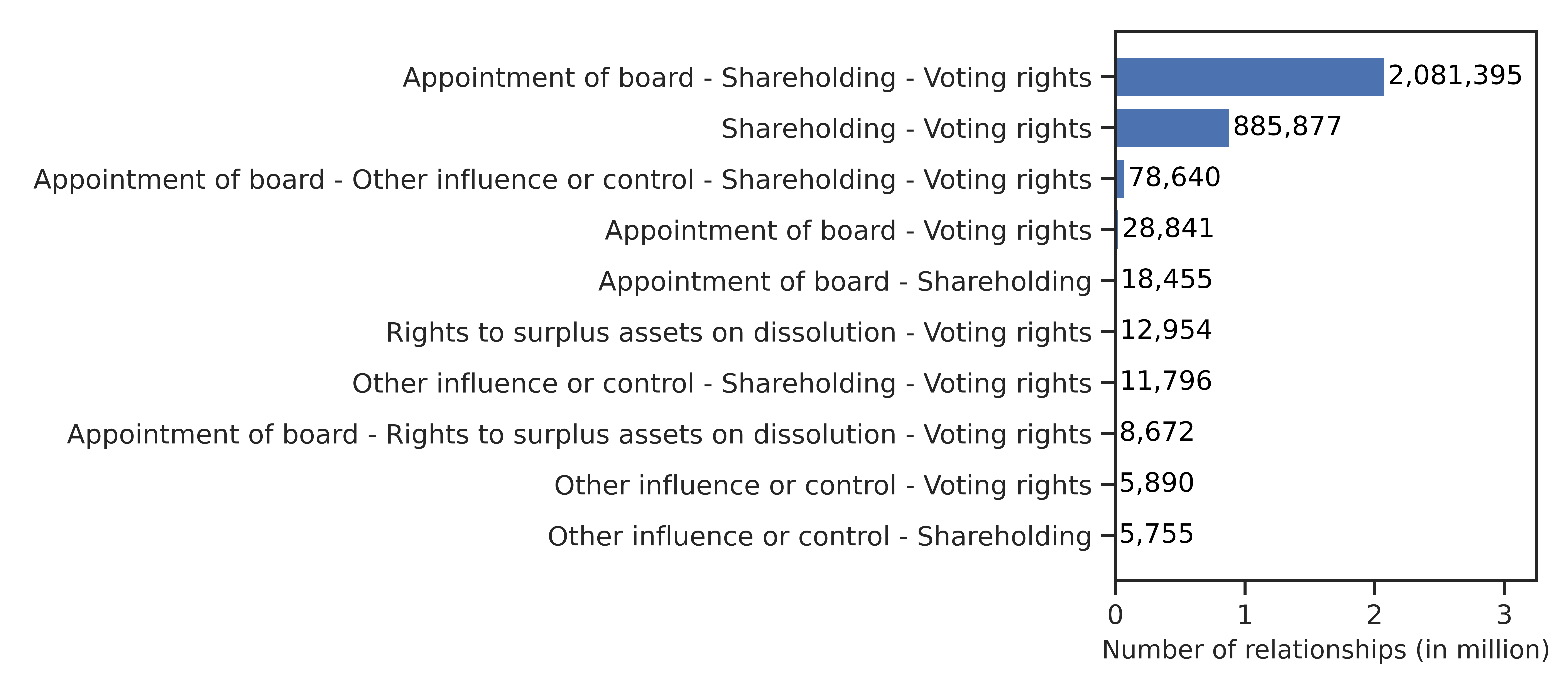
Notably, combinations involving both shareholding and voting rights consistently show identical threshold range distributions, with 57% of cases falling within the 75–100% threshold for both. This pattern suggests a one-share-one-vote structure, indicating strong alignment between ownership and control.
Table 2. Frequency of the most common percentage ranges for shareholding and voting rights among different combinations
| Shareholding range | Voting rights range | Frequency (percentage of the total) |
|---|---|---|
| 25–50% | 25–50% | 1,172,544 (38%) |
| 50–75% | 50–75% | 129,737 (4%) |
| 75–100% | 75–100% | 1,755,427 (57%) |
4.5 Entities with at least one individual beneficial owner holding multiple interests in a single entity
Among the 2.6 million entities linked to the 3.1 million beneficial owners who hold multiple interests, 80% (2.1 million entities) are controlled by a single beneficial owner. These cases suggest relatively straightforward ownership structures, where one person maintains full control through a combination of interests.
The remaining 20% (512,873 entities) have multiple beneficial owners, with at least one holding multiple interests. In 93% of these cases (477,344 entities), there are exactly two beneficial owners, one of whom holds multiple types of interests. However, a small number of outlier cases involve highly complex structures with up to 41 individual beneficial owners.
In the most extreme instance, all 41 individual beneficial owners are recorded as holding both board-appointment rights and voting rights, with each declaring voting rights in the 25–50% range. This result is an anomaly and clearly inaccurate, as their combined voting rights would far exceed 100%. A manual check on the UK PSC register confirms these disclosures, highlighting the need for automated validation systems capable of flagging mathematically implausible entries. Such inconsistencies, though rare, warrant further scrutiny by the registrar.
The persistence of complexity, even within this narrowly defined subset, underscores broader structural limitations. UK regulations that allow intermediary entities to be registered as corporate beneficial owners – combined with the lack of structured legal ownership data – complicate efforts to reconstruct full ownership chains. Integrating structured shareholder data with BO records would greatly improve the ability to trace direct and indirect ownership and identify ultimate control within complex networks.
Entities with two beneficial owners, one holding multiple interests
Among the 477,344 entities with exactly two beneficial owners and where at least one holds multiple interests, 83% (about 400,000 entities) show the same type of interest combination shared between owners. Within this group, 52% report a combination of shareholding and voting rights, while 43% include shareholding, voting rights, and board-appointment rights (Figure 8).
Figure 8. Top ten interest combinations for pairs of beneficial owners of entities where at least one beneficial owner holds multiple interests
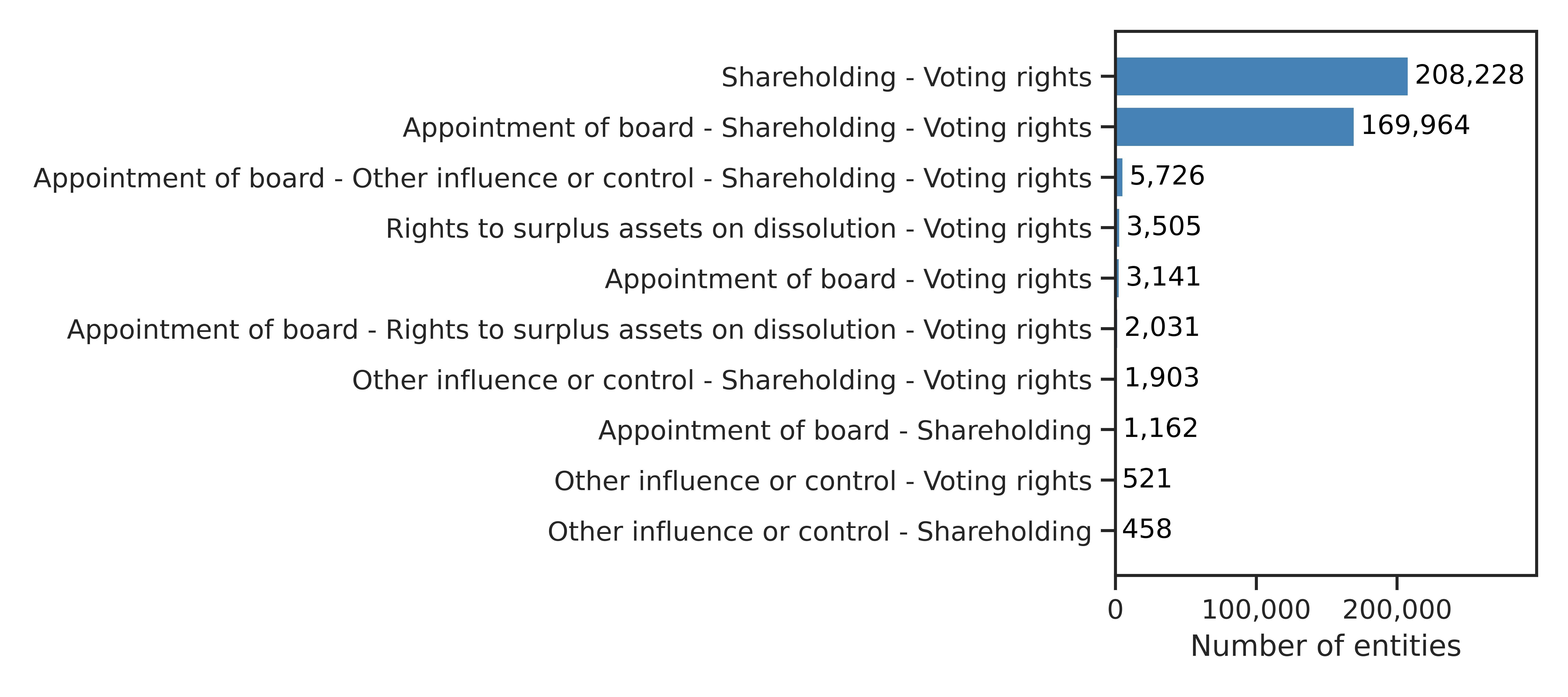
The lower end of the distribution requires closer attention, particularly in instances where other influence or control is declared alongside either shareholding without voting rights (458 entities) or voting rights without shareholding (521 entities). These cases may reflect either inconsistencies in reporting or genuinely complex ownership arrangements that warrant further investigation.
Notably, in the top three combinations shown in Figure 8 (383,918 entities), both beneficial owners report identical percentage ranges for shareholding and voting rights, most likely indicating 50/50 split (Table 3). While the disclosure format prevents precise confirmation, this suggests a general tendency towards balanced ownership rather than disproportionate distributions, such as 99/1 splits, which may indicate symbolic ownership arrangements.
Table 3. The most common percentage range combinations for shareholding and voting rights (first three categories in Figure 8)
| Interest combination | Most common range | Shareholding frequency | Voting rights frequency |
|---|---|---|---|
| SH+VR | 25–50% | 195,308 (94%) | 195,263 (94%) |
| AOB+SH+VR | 25–50% | 151,961 (89%) | 151,817 (89%) |
| AOB+OIoC+SH+VR | 25–50% | 4,870 (85%) | 4,863 (85%) |
Reference: SH (Shareholding), VR (Voting rights), AOB (Appointment of board), OIoC (Other influence or control).
4.6 Summary of segment-specific analysis and associated ownership dynamics as well as anomalous patterns
The following table summarises key findings across different segments of the dataset, highlighting ownership dynamics and identifying anomalous patterns that may warrant further scrutiny.
Table 4. Summary of segment-specific analysis: Ownership dynamics and anomalous patterns
| Segment of the dataset | Ownership dynamics | Anomalous patterns |
|---|---|---|
| Entities with no individual beneficial owners (20% of active entities) | 93% have no beneficial ownership records at all; 7% list only intermediary entities as beneficial owners, with 64% of these linked to a single intermediary | One entity listed 18 intermediary entities as beneficial owners, creating a highly layered and opaque ownership network |
| Individual beneficial owners with multiple entity connections (12% of all individuals) | Most are linked to just two entities | Outlier cases include individuals linked to over 800 entities, e.g. individual listed as the beneficial owner of 1,296 entities |
| Individual beneficial owners with single entity connections (88% of all individuals) | 31% hold a single type of interest; 69% hold multiple interests, most commonly a combination of shareholding, voting rights, and board-appointment rights (66%) | Among those with a single interest, approximately 280,000 report other influence or control without shareholdings or voting rights (potentially because they are senior managers) |
| Entities with at least one individual beneficial owner holding multiple interests (43% of all entities) | 80% are controlled by a single individual with multiple interests; 20% involve multiple beneficial owners, with 92% of these having exactly two owners | One entity linked to 41 individual beneficial owners, all declaring board-appointment and voting rights within the 25–50% range, exceeding ownership limits |
Footnotes
[26] See: “The companies we keep: What the UK's open data register actually tells us about company ownership”, Global Witness, 1 December 2020, https://globalwitness.org/en/campaigns/corruption-and-money-laundering/the-companies-we-keep/.
[27] “UK People with Significant Control”, OCCRP Aleph, accessed 8 April 2025, https://aleph.occrp.org/datasets/2053.